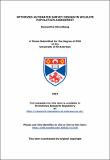Files in this item
Optimized automated survey design in wildlife population assessment
Item metadata
| dc.contributor.advisor | Buckland, S. T. (Stephen T.) | |
| dc.contributor.advisor | Jupp, Peter E. | |
| dc.contributor.author | Strindberg, Samantha | |
| dc.coverage.spatial | x, 371 p. | en_US |
| dc.date.accessioned | 2017-07-28T13:25:36Z | |
| dc.date.available | 2017-07-28T13:25:36Z | |
| dc.date.issued | 2001-05 | |
| dc.identifier.uri | https://hdl.handle.net/10023/11318 | |
| dc.description.abstract | Increased pressure on the environment has placed numerous ecological populations under threat of extinction. Management schemes dedicated to the future conservation of wildlife populations rely on effective monitoring of the size of those populations. This requires that accurate and precise abundance estimates are obtained for the purposes of wildlife population assessment. The accuracy and precision of estimates are determined to a large extent by the survey design used to obtain population samples. Methods for optimizing the survey design process are detailed, with a particular- focus on automating the sui-vey designs using computer software. The technique of automated survey design is a simulation-based tool, which provides the means to assess the properties of any type of survey design, permits the evaluation of abundance estimates over sui-vey regions with assumed population densities, and from a practical standpoint facilitates the creation of a survey plan that can be implemented in the field. Survey design properties include the probability of a particular location being included in the sample, the spatial distribution of the sampling locations within the survey region, and the distances covered by observers to obtain the sample data. The design properties are directly linked to the accuracy and precision of estimates, as well as the efficiency, achieved by a type of design. A comparative study of a number of different survey designs that can be broadly classified as systematic or non-systematic is presented. The simulation results show their performance with regard to the above-mentioned properties and the abundance estimates obtained if the designs are applied to some known population densities. Due to the more even spatial distribution of the systematic designs the estimates they produce are potentially more precise and the distances covered by observers less variable as well. It is also shown how biased estimates can result if the probability of a particular location being included in the sample is assumed to be even over the entire survey region when it is not. The problems associated with surveying along the boundary of a survey region and within non-convex regions are addressed. The methods are illustrated with a number of survey design examples. | en_US |
| dc.language.iso | en | en_US |
| dc.publisher | University of St Andrews | en |
| dc.subject.lcc | QA276.6S8 | |
| dc.title | Optimized automated survey design in wildlife population assessment | en_US |
| dc.type | Thesis | en_US |
| dc.type.qualificationlevel | Doctoral | en_US |
| dc.type.qualificationname | PhD Doctor of Philosophy | en_US |
| dc.publisher.institution | The University of St Andrews | en_US |
This item appears in the following Collection(s)
Items in the St Andrews Research Repository are protected by copyright, with all rights reserved, unless otherwise indicated.

